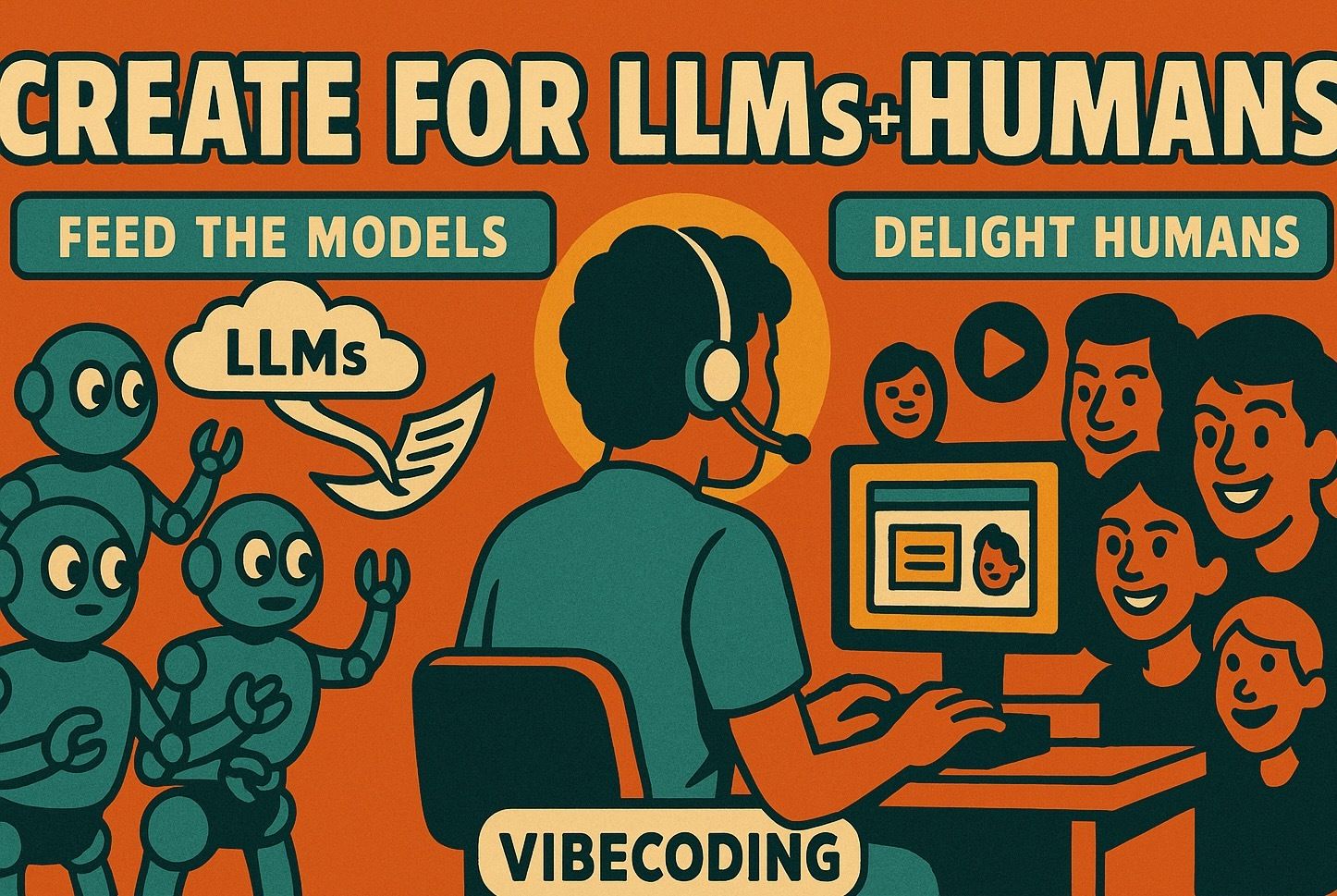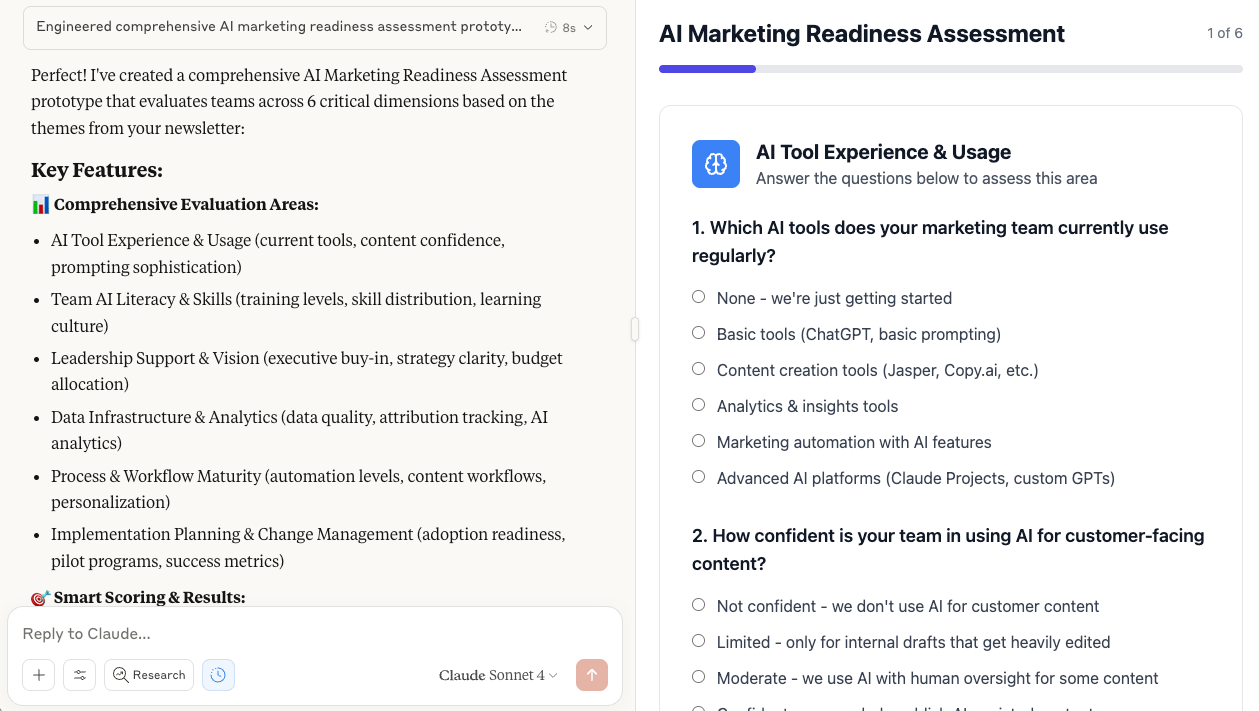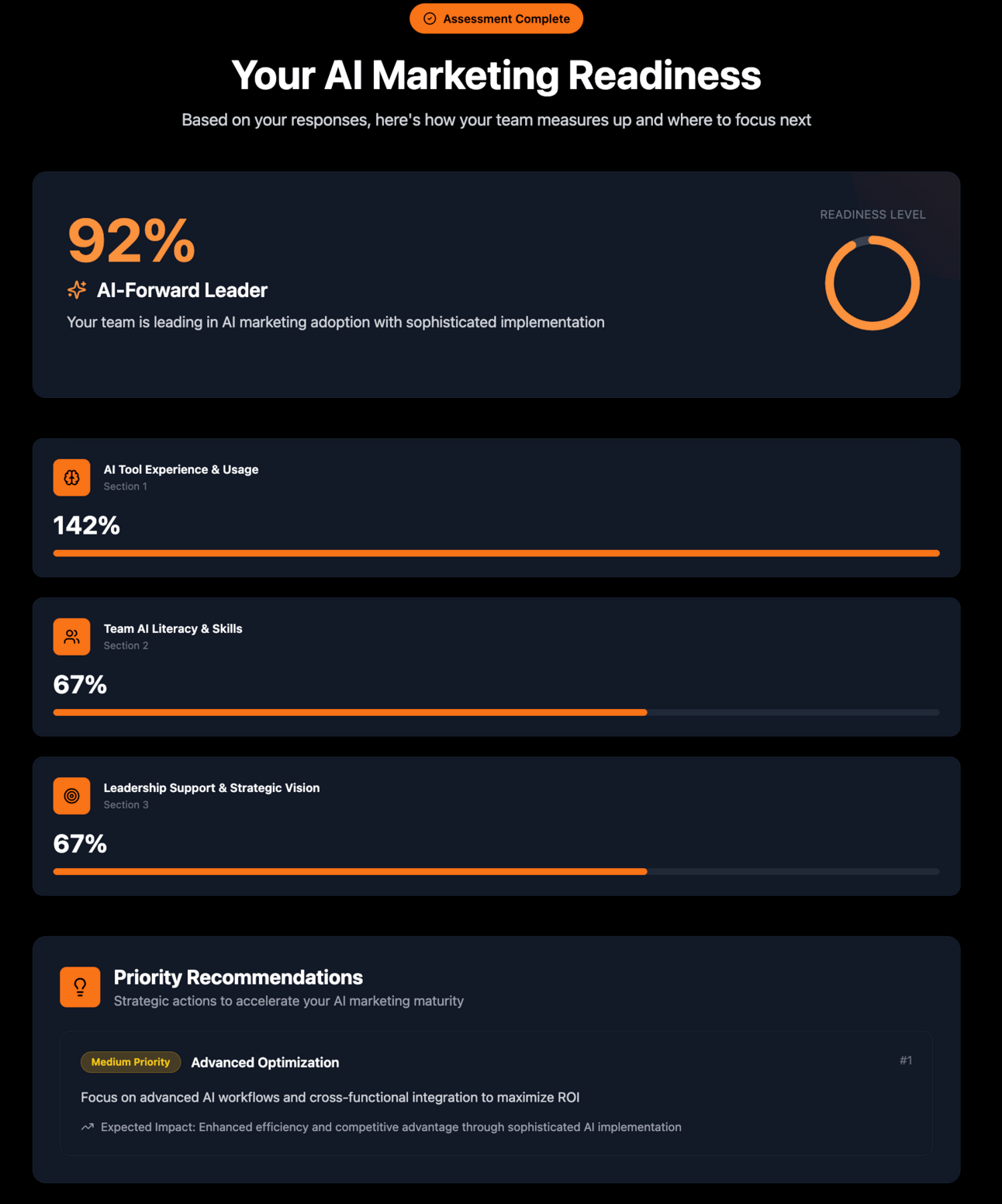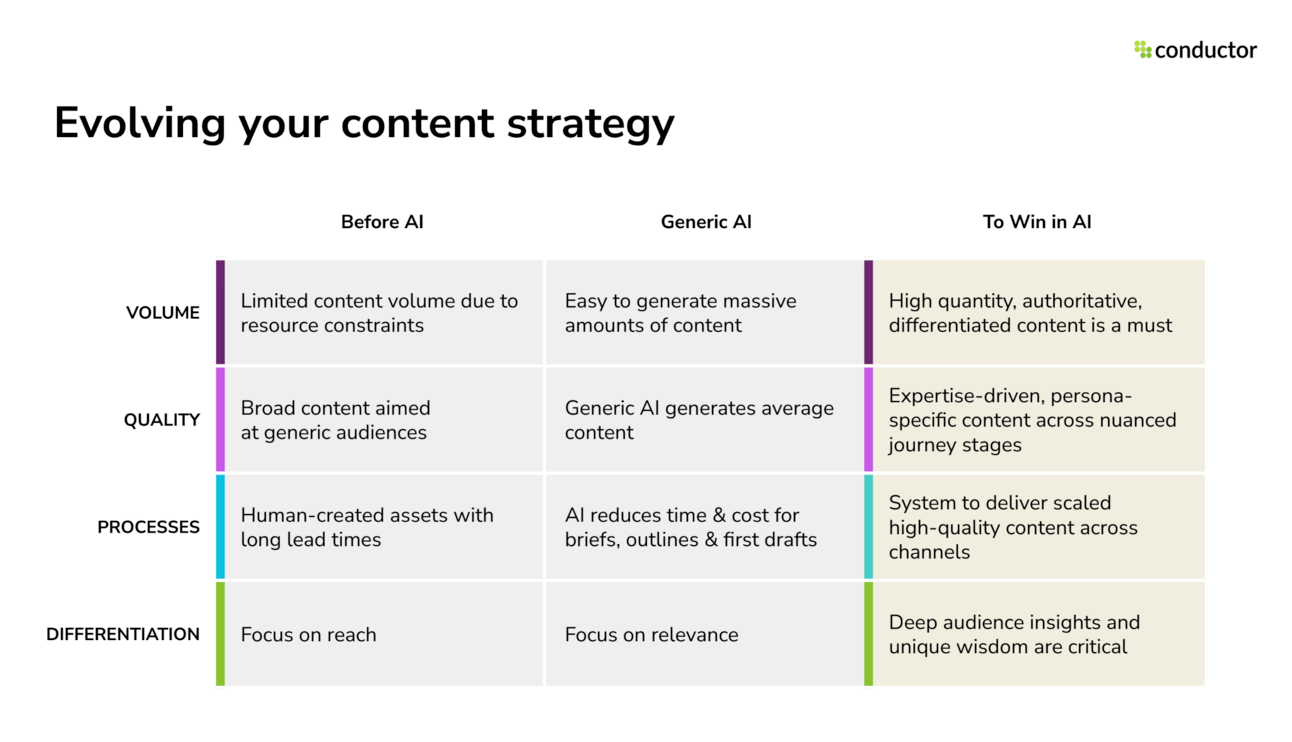- Francois' Highlights
- Posts
- The new bar for content - Part II: vibecoding
The new bar for content - Part II: vibecoding
Content to both humans and LLMs | Vibecoding with Claude | 3 AI use cases for Product Marketing | More intel and tips for AIO | 3 ways to get better at AI
If you only check one highlight this week:
CMO involved in content marketing? » The first two sections
Product Marketer? » Three great AI workflows from Hubspot’s PMM leader
Everyone else » 3 ways to get better at AI right now
-François
Thanks for sharing these highlights with busy marketing execs around you.🙏

Why we need to create content for both LLMs AND humans + where vibecoding comes in
tl;dr: create short form and engaging experiences for humans - videos, apps, short newsletters, etc - AND keep producing content at scale to feed LLMs.
Last week, I covered some* of the recent progress in AI video gen, which brings new opportunities for short-form content creation at low cost and higher speed.
Today = why and how we need to create more content formats - and the role of interactive experiences - as we are seeing significant drops in visits and traffic from traditional SEO efforts.
The trends
Organic traffic is significantly down despite much higher content creation volumes.
Target accounts research solutions in ChatGPT, Gemini or Perplexity, instead of systematically starting with Google. Even if they do, they increasingly consume AI overviews instead of clicking on blue links.
Our thought leadership gets processed by AI models before reaching human decision-makers.
That Reddit thread about your competitor? It's outranking your domain authority in AI search results.
So what?
We're now creating content for two completely different audiences with fundamentally different consumption patterns:
AI models that synthesize, hopefully reference, and redistribute your content to influence human research and decision making
Humans with limited attention spans who increasingly rely on AI to pre-digest information or favor easy and/or engaging consumption
Why Content for AI Matters
When prospects query "best identity security solutions" in ChatGPT, your positioning needs to be embedded in the model's response, or you're invisible.
AI training data over-indexes, so far, on:
Reddit discussions and Quora threads (due to licensing agreements with ChatGPT or Google) and other forum conversations and community content
Various 3rd party websites, regardless of domain authority seemingly, with less emphasis on vendor websites :-/
Our share of voice in AI search results now matters as much as our Google rankings once did.
This means we need content that educates AI models about our positioning, differentiators, customer reviews, and use cases. Think of it as building institutional memory in the systems that increasingly influence B2B buying decisions.
How to better engage humans with content
For direct human consumption, we’re seeing the rise of:
Micro-content that respects attention constraints, i.e. the “TikTok-ification of B2B education”
Personal and/or interactive experiences that AI search cannot replicate or replace for now
Those 2,000-word e-books, white papers or industry analyses will get AI-summarized anyway by LLMs or the readers’ AI.
So let’s create our own versions of education experiences that make the consumption of our content interactive and personal!
Let’s replace:
Static maturity models with interactive assessments that create personal recommendations and track progress (see how I vibecoded a proof of concept in only 20 minutes in the next section)
Spreadsheet-based ROI calculators with elegantly-designed tools that also collect unstructured customer context for discovery
Feature comparisons tables with interactive decision frameworks
Vibe coding to turn your content into interactive experiences.
These interactive experiences don't require a full engineering team or sprint.
With vibe coding tools - such as Claude artifacts, Lovable, V0, or Replit - you can use AI to rapidly prototype functional apps without knowing how to code, by simply mastering English and prompting.
They’re so easy to use that the only challenge is coming up with an idea for an app.
They’re good at creating simple customer-facing tools, internal tools OR proof of concepts that share your vision with a developer, if your app has advanced requirements (complexity, security, handling of data, etc).
These coded experiences accomplish what static content doesn’t do as well. They:
engage prospects
can capture behavioral intent signals
create differentiated touchpoints that AI cannot commoditize
And they're fun to build. See below 👇
* Want to learn more about AI Video Gen for creators on social media? This podcast taught me a lot (watch, don’t listen).
👨💻 How I vibecoded a proof of concept in 20 min
Claude Artifacts (free and easy 60-min primer here) got an upgrade recently:
“You can now turn a Claude chat prompt into a hosted mini‑app that you can share with a link. This shifts Claude from assistant to lightweight no‑code platform”.
To test it out, I turned my newsletter’s static content into a quick interactive prototype. You can do the same with Lovable or other vibecoding apps.
In just a few minutes, after analyzing my newsletters’ content, Claude:
suggested interactive apps and corresponding functionality
created this prototype
Below is how I did it.
Imagine how far you can go by dedicating just a little more time.
1️⃣ I used this prompt in Claude:
I have been publishing a newsletter to help B2B marketers understand how to “market in the AI era”.
Analyze the 15 issues and, based on this, recommend interactive apps I could build to make this more engaging. https://francois-highlights.beehiiv.com/
2️⃣ Claude analyzed my content and suggested an app.
It suggested an “AI Marketing Readiness Navigator” with these features:
Assessment: Interactive questionnaire covering the key areas you write about. Results in a personalized "AI Marketing Maturity Score" with visual dashboard
Personalized Recommendation: suggests AI tools, use cases & strategies
Implementation Planner: customizabe planning tool, with readiness checklists
Use Case Explorer: Searchable DB of AI marketing use cases.
Progress Tracking Dashboard: Track AI implementation journey over time.
3️⃣ I asked Claude to prototype the first feature only
The right side of the screenshot below shows the first pass. The left, the capabilities it built.

Claude artifact turns my content into app ideas and the app itself!
4️⃣ I asked Claude to make it look nicer and consistent with my branding
I told it to analyze my newsletter style guide and uploaded a screenshot of a website I like.
5️⃣ I hit “publish” and tested it
I could easily have iterated on the content by simply prompting back and forth, but I wanted to push this prototype fast first as proof of concept.

Once I completed the assessment form, the app created a visual summary and generates recommendation.
My selection of tips, news and workflows
🤖 Three AI use cases for product marketers
The Head of PMM at HubSpot shared three powerful AI use cases for Product Marketing. Here is a summary + my tips, but it's worth watching the entire podcast, which includes:
1️⃣ Creating and using rich Ideal Customer Profiles (ICP) in Claude or ChatGPT - video
Turns firmographic, technographic, and behavioral data into living ICPs so Sales and Marketing understand and target the right buyers and improve messaging.
2️⃣ Competitive intelligence and Battle Card Agent with Google NotebookLM - video
Create an all-knowing competitive chatbot re. how you win vs competitors that Sales can tap into anytime.
3️⃣ Customer interviews at scale using AI - video
You can run many qualitative customer interviews in much less time, get verbatim quotes, summaries and tag themes in the time a human team runs two calls.
📉 More intel and tips for AI search optimization
Analysis and recommendations from the Chief Product Officer at Conductor, a website Intelligence and Optimization Platform:
Shifts in Search Behavior: AI search is characterized by longer prompts, a higher percentage of "no-click" searches, and significant declines in paid CTR when AI Overviews are present. AI crawlers are also indexing deeper pages.
Impact on Organic Traffic & Conversions: Seeing declines in average organic traffic. AI platforms like ChatGPT, Perplexity, Claude, and Gemini show much higher conversion rates compared to Google Organic search.
Evolving Marketing Metrics: New metrics are needed to measure AI search performance, including brand visibility, topical authority, brand mentions, and citation frequency.
Content Strategy Adaptation: Winning in AI requires a shift from limited, generic content to high-quantity, authoritative, and differentiated content. Focus on expertise-driven, persona-specific content across nuanced journey stages, with processes to deliver scaled, high-quality content.

🛠️ Three ways to get better at AI right now
The AI Daily Brief podcast shares how to outpace most people in AI mastery.
Recommend listening the full thing when you can.
tl;dl:
1. Use OpenAI's o3 Model as a Strategic Collaboration for one week
Draft comprehensive memos from rough ideas and strategic rambles
Generate scenarios for major decisions (frameworks, not final answers)
Use Deep Research for industry analysis that typically takes weeks
2. Vibe Coding with No-Code AI Tools
Prototype feature ideas instead of describing them - show, don't tell
Build side project prototypes you've always imagined
Recreate childhood games to master complex workflow design
3. Build Agentic Workflows Manually
Create automated workflows using Zapier, Relay, Make, or n8n
Focus on research flows, sales outreach, and content generation
Learn workflow mapping before consumer agents abstract the complexity
Bonus Advanced Moves:
Experiment with emerging consumer agents (Gens Spark, Manus)
Explore Model Context Protocol (MCP) for next-level agent data integration
Stop waiting for courses and certificates - start building, experimenting, and having fun.
Final Words
There are no AI experts - only people who have practiced more than you.
Someone forwarded you this email? You can subscribe here.
François | LinkedIn
I'm a CMO, advisor, and "CMO Wingman". Yes, that's a thing :-). Ask my clients: in this AI era, CMOs need a strategic proactive advisor more than ever. I’m former CMO at Twilio, Augment Code, Apollo GraphQL, Decibel, Udacity and Head of Marketing for LinkedIn Talent Solutions.